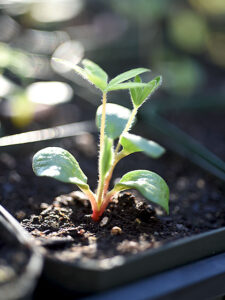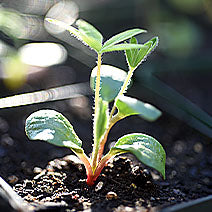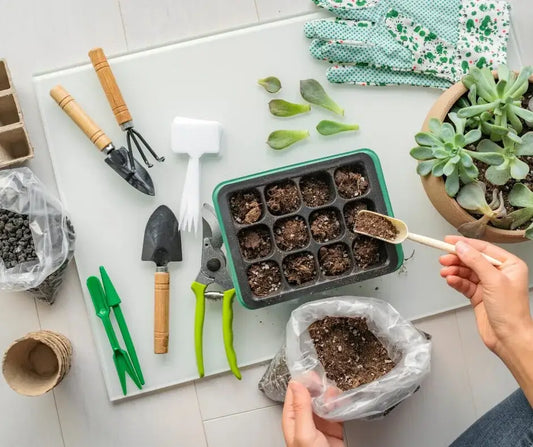 Spring is so fickle. The temperatures go up, the temperatures drop down. It’s way too risky to start planting in the ground. But there is a totally satisfying alternative that will fulfill all your urges to play in the soil. Plus, it’s loads of fun. You need to plant seeds. Really, once you’ve given seed sowing a try, you’ll be hooked. And it’s surprisingly easy. Of course, you can purchase all sorts of bells and whistles to make it happen. Or you can go the simple route and do it in a snap without any special equipment besides a seed flat, some seeds, and seed starting mix. For the mix: Coast of Maine has formulated a super seed starting blend to streamline the magic. Sprout Island Blend Organic & Natural Seed Starter works beautifully. You can do this!
Spring is so fickle. The temperatures go up, the temperatures drop down. It’s way too risky to start planting in the ground. But there is a totally satisfying alternative that will fulfill all your urges to play in the soil. Plus, it’s loads of fun. You need to plant seeds. Really, once you’ve given seed sowing a try, you’ll be hooked. And it’s surprisingly easy. Of course, you can purchase all sorts of bells and whistles to make it happen. Or you can go the simple route and do it in a snap without any special equipment besides a seed flat, some seeds, and seed starting mix. For the mix: Coast of Maine has formulated a super seed starting blend to streamline the magic. Sprout Island Blend Organic & Natural Seed Starter works beautifully. You can do this!Getting Started
 Where should you get started? Some seeds are easier than others to sow—so consider starting simple. In general, annuals are less work than most perennials to grow from seed. In particular, marigolds, zinnias, cosmos, basil, and many other annuals are a great and gratifying place for beginners to wade in. Not only do they germinate rapidly, but they also require no extra care. On the other hand, perennial seeds often prefer a cold sequence in the refrigerator or outdoors to trick them into thinking that they’ve gone through a winter cycle outdoors before sprouting. Perennials that require a cold period often prefer a specific number of days of chilly temperatures to satisfy their needs. But many require no cold snap whatsoever. The seed packet should reveal all the specs you need to know. In general, seed packets are “required reading” when sowing and growing seedlings. They usually tell all, including suggestions on when the seeds should be sown. That date varies according to your region, but it’s generally a matter of counting back from your last frost date—and you can find your last frost date online. Some seeds are slower than others to sprout. The packet should also reveal whether seeds need light to germinate or if they should be covered with a layer of soil. Other unique requirements are also often mentioned to make your mission a success.
Where should you get started? Some seeds are easier than others to sow—so consider starting simple. In general, annuals are less work than most perennials to grow from seed. In particular, marigolds, zinnias, cosmos, basil, and many other annuals are a great and gratifying place for beginners to wade in. Not only do they germinate rapidly, but they also require no extra care. On the other hand, perennial seeds often prefer a cold sequence in the refrigerator or outdoors to trick them into thinking that they’ve gone through a winter cycle outdoors before sprouting. Perennials that require a cold period often prefer a specific number of days of chilly temperatures to satisfy their needs. But many require no cold snap whatsoever. The seed packet should reveal all the specs you need to know. In general, seed packets are “required reading” when sowing and growing seedlings. They usually tell all, including suggestions on when the seeds should be sown. That date varies according to your region, but it’s generally a matter of counting back from your last frost date—and you can find your last frost date online. Some seeds are slower than others to sprout. The packet should also reveal whether seeds need light to germinate or if they should be covered with a layer of soil. Other unique requirements are also often mentioned to make your mission a success.
Laying the Groundwork
 To sow your seeds, you’ll need a shallow container with good drainage. Fill the container with Coast of Maine’s Sprout Island Seed Starter (it’s the perfect consistency for seed sowing) and tamp the surface down to create a flat, firm, level space for sowing. After sowing the seeds using the method suggested on the seed packet, tamp them down to firm the soil around the seed. Then water lightly using a spray bottle or fine nozzle watering pot. Even better—let the flat soak in a pan to water the seeds from below. The soil should be moist but not heavily saturated with water. Most annual seeds prefer a warm, bright location to sprout. You could use a heat mat and artificial lights, but a sunny, warm window works in most cases. Now it’s just a matter of keeping the seed flat lightly moist and patiently watching for action (while protecting your seed flat from pets who love to play “farmer.”) The waiting is the hardest part.
To sow your seeds, you’ll need a shallow container with good drainage. Fill the container with Coast of Maine’s Sprout Island Seed Starter (it’s the perfect consistency for seed sowing) and tamp the surface down to create a flat, firm, level space for sowing. After sowing the seeds using the method suggested on the seed packet, tamp them down to firm the soil around the seed. Then water lightly using a spray bottle or fine nozzle watering pot. Even better—let the flat soak in a pan to water the seeds from below. The soil should be moist but not heavily saturated with water. Most annual seeds prefer a warm, bright location to sprout. You could use a heat mat and artificial lights, but a sunny, warm window works in most cases. Now it’s just a matter of keeping the seed flat lightly moist and patiently watching for action (while protecting your seed flat from pets who love to play “farmer.”) The waiting is the hardest part.
Jubilation! They’ve Sprouted
 When seeds start to sprout, it’s thrilling. In most cases, you should provide as much light as possible to get them off and running in the right direction. Transplanting to individual pots is also part of the fun. Do it when the seedlings are young—usually when they’ve formed their first real leaves. Waiting too long can actually set the little fellas back. Take care to tease the roots gently free from their neighbors, disturbing them as little as possible. A light blend such as Coast of Maine’s Bar Harbor Blend Organic Potting Soil is just the ticket. Firm the seedling into its new container and then water it gently. Shade the new transplant for a day or two while it recovers from the disruption. As the weather warms up, you might bring your seedlings outdoors to acclimate to life in the garden but be careful to make the transition to the Great Outdoors gradually. Put the seedlings in a shady location for several days while they make the adjustment. Also watch carefully for chilly temperatures and shelter the seedlings indoors if temperatures plummet. Seedlings like zinnias prefer warm temperatures both day and night—so baby them indoors until the weather is reliably toasty.
When seeds start to sprout, it’s thrilling. In most cases, you should provide as much light as possible to get them off and running in the right direction. Transplanting to individual pots is also part of the fun. Do it when the seedlings are young—usually when they’ve formed their first real leaves. Waiting too long can actually set the little fellas back. Take care to tease the roots gently free from their neighbors, disturbing them as little as possible. A light blend such as Coast of Maine’s Bar Harbor Blend Organic Potting Soil is just the ticket. Firm the seedling into its new container and then water it gently. Shade the new transplant for a day or two while it recovers from the disruption. As the weather warms up, you might bring your seedlings outdoors to acclimate to life in the garden but be careful to make the transition to the Great Outdoors gradually. Put the seedlings in a shady location for several days while they make the adjustment. Also watch carefully for chilly temperatures and shelter the seedlings indoors if temperatures plummet. Seedlings like zinnias prefer warm temperatures both day and night—so baby them indoors until the weather is reliably toasty.  And that’s it! You are going to love being a seed parent. Not only is it gratifying, but growing from seed will save you a bundle of money. Plus, you can select the exact color of marigold, cosmos, or whatever plant you fancy. You will become a fan of seed starting, for sure. So here’s an idea: Share your newfound hobby and knowledge with others. Growing seeds is a great project for newbie gardeners of all ages.
And that’s it! You are going to love being a seed parent. Not only is it gratifying, but growing from seed will save you a bundle of money. Plus, you can select the exact color of marigold, cosmos, or whatever plant you fancy. You will become a fan of seed starting, for sure. So here’s an idea: Share your newfound hobby and knowledge with others. Growing seeds is a great project for newbie gardeners of all ages.Written by award winning author, Tovah Martin. Photos also taken by Tovah Martin. Find her books and more information on her website: tovahmartin.com.













